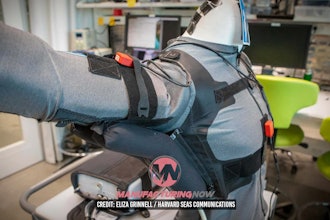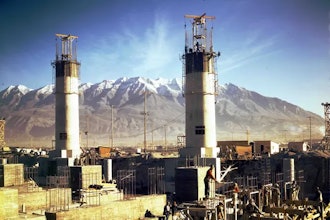
Warning: Everything You Know
About Med Design Is Wrong
Make Your PLM System the Product Design
Utopia to Win Big in Medical Device
Whitepaper
arenasolutions.com
©2015 Arena Solutions, Inc. Arena and Arena Solutions are trademarks of Arena Solutions, Inc., Reg. U.S. Pat. & Tm. Off.
All rights reserved. Other product and company names are the property of their respective holders. 1
arenasolutions.com
An Industry Defined By High Hurdles and High Margins
Developing a medical device has always been a complex process.
Manufacturers must continue to drive innovation while
facing ever-intensifying business challenges, including the
onslaught of fierce competition, the difficulty of managing
globally dispersed teams, and an increasing need to
address quality and risk. On top of this already challenging
state of affairs, OEMs must also comply with strict and ever-
changing regulatory requirements imposed by governing
agencies around the globe.
So how does a medical device manufacturer navigate this
balance beam at high speed?
It’s a tall order, because so much is involved in developing
a medical device —component change complications
are increased, compliance challenges magnified, and risks more dangerous than other industry. After all, human
lives are at stake. And every time a medical device company makes a single change to a product design, the
government needs to know — and it doesn’t matter whether it’s just a labeling issue or single component change.
And here’s where things get really crazy: the medical device industry has such extended regulatory approval
cycles that by the time a part is approved — it can be deemed obsolete. Replacing the part means the submission
process starts all over again.
Gasp.
The medical device industry is defined by a number of high hurdles that stand in the way of an OEM’s success. But
for those who can overcome these challenges there is the promise of high margins…and vast riches.
The only way to manage the entire medical device product lifecycle – from regulatory compliance, to global
monitoring, quality assurance, risk management and part nonconformance – is through a holistic approach that
brings all of these moving parts together into a single, integrated view. When quality, design control processes,
and risk management are embedded as an integral part of the day-to-day product design and development cycle,
OEMs can dramatically reduce supply chain oversights, employee missteps and product design errors.
Misleading reports that extol the virtues of “best of breed” solutions, so-called “linked” systems, and even the
traditional model of isolated systems claim to be able to deliver the holistic solution described above; however,
recent evidence points to the contrary. Medical device executives, whose use of siloed systems has led to product
delays, scrap, rework and risk exposure, can attest to the painful truth that everything they had been told about
medical design control was…wrong.
According to an Aberdeen Group report, embedding quality and design control processes within a product
lifecycle management (PLM) solution can reduce internal and external failure costs by more than 50 percent and
the total cost of quality by 8 percent.1
©2015 Arena Solutions, Inc. Arena and Arena Solutions are trademarks of Arena Solutions, Inc., Reg. U.S. Pat. & Tm. Off.
All rights reserved. Other product and company names are the property of their respective holders. 2
arenasolutions.com
For medical device companies, the ideal design environment to avoid risk and ensure quality is a three layer
stack: the foundation is a modern cloud-based PLM solution with an extensible architecture to support a range of
current and future integrations; next is an embedded quality module with corrective and preventive action (CAPA)
capabilities; the final layer are next generation design solution integrations, add-ons — and even component
databases — all woven into the PLM-driven design environment.
In this medical device-focused whitepaper, we look at strategies and modern solutions that when integrated
together can improve quality, streamline design control processes, reduce risk, control design and accelerate
innovation. As we search for a utopian medical device design environment, we cover the following topics:
• Why PLM?
• Advantages of Integrating Quality with PLM
• Strategies for Managing REACH and RoHS Risks
• How to Reduce Obsolescence and Counterfeit Parts
• Extending Your PLM Solution
Why PLM?
Before we begin to delve into buzzwords, such as “holistic
solutions,” “complete quality pictures” and “enterprise-wide
visibility”, let’s investigate why PLM is the first step in a
medical device company’s plan to reduce risk and ensure
quality in their design processes.
To start with, PLM was created to allow all product
companies — not just medical device OEMs — to better
manage documents to streamline their extended supply
chain efficiencies, improve cross-functional collaboration
and increase enterprise-wide visibility into the design process.
By this very function alone — coupled with configurable
routing and electronic signatures — companies can reduce
costly risks and significantly improve compliance processes.
PLM specifically helps medical device OEMs by empowering them with greater management control over their
quality documents. This expansive list of quality-related documents includes bill of material (BOM), change orders,
design history files (DHF), device master records (DMR), validation and verification certifications, risk management
reports and product records. And let’s not forget the need for a well-documented paper trail for 21 CFR Part 11, 21
CFR Part 820 and CAPA.
PLM offers greater document control for med device companies by consolidating all design information in one
centralized system, enabling OEMs to easily share BOMs with globally dispersed suppliers. Because quality-
related documents can be complicated (a DMR is an enormous compilation of records containing the procedures
and specifications for a finished medical device), a solution like PLM is necessary to avoid misplacing documents
and keeping a tight reign on version control.
Collaborative Quality
Management Life Cycle
Collaborative
quality
management
life cycle
Requirements de nition
and management
Build and release
management
ConstructionTesting
Analysis and
design
Risk
management
Test
management
Defect
resolution
Analytics
Dynamic
planning
Coverage
analysis
©2015 Arena Solutions, Inc. Arena and Arena Solutions are trademarks of Arena Solutions, Inc., Reg. U.S. Pat. & Tm. Off.
All rights reserved. Other product and company names are the property of their respective holders. 3
arenasolutions.com
When quality processes (CAPAs, supplier corrective action requests (SCARs), corrective action requests (CARs),
NCMRs, 8D, etc.) are integrated into the PLM system, supply chain teams have access to the quality product
records, enabling them to be proactive rather than re-active in managing quality. And because this information is
tracked and visible throughout the organization, auditors can quickly and easily verify compliance.
Advantages of Integrating Quality with PLM
In today’s hyper-competitive medical device market, medical device companies must balance the need to meet
increasingly stringent regulations while continuing to innovate quickly and be first to market. To succeed, medical
device companies should ensure these quality best practices:
• Processes complement one another: Manufacturing, engineering, quality control and compliance
management must all work together to control costs and shorten development cycles and retain a ‘First
Mover’ advantage.
• Compliance becomes part of the culture: Medical device developers must embed compliance into
the day-to-day work life of all global teams; otherwise employees will never be able to keep up with,
much less meet, the ever changing array of local regulatory requirements.
• Ongoing, global monitoring of risks: Again, organizations need to take a holistic monitoring
approach to account for the diversity of risks a medical device OEM faces, including lifecycle,
compliance, multi-sourcing and inventory risks.
• Ensure everyone participates: If the quality process is relegated to an isolated team using an
isolated system, it is almost a guarantee that the product will face quality issues. Quality processes
must be integrated into the day-to-day product record so that everyone, including members of the
extended supply chain, can contribute to producing the highest quality product.
LNS Research recently released the results of a quality management survey that showed medical device
executives ranked the ability to “better manage operational risk” and “ensuring compliance” as the top two quality
management objectives. The roadblocks that executives felt kept them from achieving those goals were “effectively
measuring quality metrics” and “disparate quality systems and data sources.”
Quality metrics are not e ectively
measured
Quality is considered a “department”
not a “responsibility”
Disparate quality systems and
data sources
Lack of visibility into supplier quality
No formal process for continuous
improvement
Engineering lacks feedback
on quality
Top Quality Management Challenges
Ch
al
le
ng
es
Percentage of Respondents Source: LNS Research
0 10% 20% 30% 40% 50%
©2015 Arena Solutions, Inc. Arena and Arena Solutions are trademarks of Arena Solutions, Inc., Reg. U.S. Pat. & Tm. Off.
All rights reserved. Other product and company names are the property of their respective holders. 4
arenasolutions.com
How Arena Helped Swan
Medical Take Flight
Swan Medical’s COO Larry Sampson
was frustrated with his company’s CAPA
processes. Unreliable and unpredictable
design controls were keeping him awake
at night. “We suffered from poor internal
understanding of process flow and inability
to produce corrective evidence,” said
Sampson. “Simply put: we had improper
information in the specified locations.”
Sampson realized he could not depend
upon divergent systems to ensure quality.
Redundancy and version control issues
were creating havoc. “With siloed systems,
it was hard enough to get the input correct
once, let alone twice in exactly the same
way,” said Sampson. The COO knew a
holistic PLM-driven approach to quality
control was the key to his medical device
company’s success.
Sampson turned to Arena PLM to streamline
his company’s design processes. According
to Sampson, Arena PLM’s change
management capabilities and document
control enabled him to improve processes
for creating, reviewing and gaining formal
approval for engineering change requests,
change orders and change notifications. He
also integrated Arena Quality into Arena PLM.
“I use all of Arena’s tools together to establish
a regulatory compliant standard work flow
for predictable outcomes,” said Sampson.
“The quality process integration is great, the
ECO management capabilities are awesome.
Arena allowed me to establish a complete
quality and risk management solution that
streamlined processes to ensure quality for
better business results.”
In addition to Arena Quality, Sampson
also integrated Arena Projects into the
design mix to flexibly track CAPA project
progress through customizable phases with
assignable milestones and tasks. “When an
auditor comes in, it’s useful to have quality
processes tied directly with project tasks,”
said Sampson. “You can click and show
them exactly where you’re at in the project
and how much time you expect to complete
the CAPA and which aspects of the system
you’re touching upon.”
Fortunately, with a PLM-based quality solution, processes are embedded into
enterprise business systems and other external data sources, producing – as
documented by this research — the following business benefits:
• Reduction of the cost of quality by up to 3X2
• A 25% increase in operating margin and a 29 percent reduction in failure costs.3
• A reduction of the cost of poor quality (COPQ), which increased earnings 10 to 15%4
When organizations employ disparate systems to manage quality, risk and other
key processes, in large part they fail to perform because there is no effective way to
retrieve recorded notes, making prior corrective actions difficult to adjudicate and
true up. Quality Digest discovered that up to “80 percent of quality issues are repeat
issues for which a corrective action has already been identified but does not persist.”5
Because of existing investments in engineering, many companies are implementing
quality management systems (QMS) and associated functionalities, such as
(CAPA), as an extension of PLM. For engineering-intensive organizations, this
helps to incorporate quality processes not only into the design phase, but also into
manufacturing, sourcing and business operations.
Extending CAPA and other QMS functionalities with PLM strengthens the feedback
loop, because it enables stakeholders to take advantage of critical information
earlier in the value chain. This rapid iterative process in new product introduction
(NPI) results in better-formalized first versions.
With a modern PLM solution, medical device manufacturers can develop a unified
information management system for engineering and quality, which creates a
single point of entry for all product and quality information irrespective of function.
Streamlining independent data sources into a centralized system delivers more
accurate product information, improves knowledge sharing, supports better design
processes, and provides improved visibility into quality information for all stakeholders.
It also eliminates the duplication of data in various disconnected systems.
The benefit of integrating quality within PLM is clear, but what other tools and
strategies can help reduce an increasingly broader array of risks and pains that
afflict and ill the medical device industry?
Strategies for Managing REACH and RoHS Risks
When introducing a new medical device onto the market, organizations should
initiate a number of well-defined risk analysis and evaluation phases. Risk
management and the performance of risk assessments are key parts of the design,
development and control process, because they help ensure that manufacturers
fully understand the product and that that designers have fully considered user
requirements, the patient and the operator.
©2015 Arena Solutions, Inc. Arena and Arena Solutions are trademarks of Arena Solutions, Inc., Reg. U.S. Pat. & Tm. Off.
All rights reserved. Other product and company names are the property of their respective holders. 5
arenasolutions.com
At a high level, ISO 14971 defines risk as the “combination of the probability of occurrence of harm and the severity
of that harm.” Risk management for medical devices is “the systematic application of management policies,
procedures and practices, to the tasks of analyzing, evaluating, monitoring and controlling risk.”
The first step in the risk assessment path is to identify the device’s potential hazards and their severity. What does
“severity” mean? One person out of a million dying due to a faulty pacemaker is a more severe “risk” than one in ten
may suffer minor burns due to poor design of an electrical component.
A single death out of a million trumps 10 small injuries in a hundred. Just ask a lawyer.
Problems in the design, development and use of the device can often be eliminated with the review of a medical
device company’s multidisciplinary team; however, the design, quality, production and operational risk assessment
can breakdown as the experts required for the overarching evaluation process tend to focus on only their specific
area, losing insight into how other elements beyond their vision can impact design.
Providing these different teams with greater enterprise-wide visibility to all processes, while also enabling them to
share knowledge with peers outside of their area is one of the key benefits of a modern PLM solution. At a high
level, Emergo Group Research recommends that teams participating in the risk assessment and management
evaluation process ask these questions:
• What is the intended use of the product?
• Is energy or a substance delivered to or extracted from the patient?
• Is the device to be routinely cleaned or disinfected by the user?
• Are measurements taken? Is maintenance or calibration necessary?
• Is the medical device susceptible to environmental influences?
• Does the medical device have software?
• Does the product have a shelf life, and what determines its useful life?
• Does product installation or use require special training?
Once the risk elements and hazards
of the product design are identified,
an analysis of each element can be
performed. Various types of hazards can
include energy, biological, environmental,
software, user error, labeling, complexity
of use and functional failure. In addition
to the Chemicals Regulation REACH
(Regulation concerning the Registration,
Evaluation, Authorization and Restriction
of Chemical substances), medical devices
companies who want to sell their products
globally must now report frequently
on use of the use of certain hazardous
substances with RoHS (Restriction of
Hazardous Substances) Directives.
Table 1: Substances banned by the RoHS Directive
Banned Substance
Lead (Pb)
Cadmium (Cd)
Mercury (Hg)
Hexavalent Chromium (Hex-Cr)
Polybrominated Biphenyls (PBB)
Polybrominated Diphenyl
Ether (PDBE)
1000 ppm
100 ppm
1000 ppm
1000 ppm
1000 ppm
Solder, batteries, ceramic components
II-VI compounds, batteries, pigments
II-VI compounds, lighting, switches
Coatings for metal housings
and chassis
Flame retardents for plastics
RoHS Limit Typical Use
©2015 Arena Solutions, Inc. Arena and Arena Solutions are trademarks of Arena Solutions, Inc., Reg. U.S. Pat. & Tm. Off.
All rights reserved. Other product and company names are the property of their respective holders. 6
arenasolutions.com
Until recently, the original RoHS compliant exempted medical devices, allowing them to contain an unlimited amount
of toxic metals and plastics. Not anymore. RoHS now targets a wide array of medical devices, and will expand to
include in-vitro diagnostic devices in 2016. The current list of devices RoHS targets include:
• Radiotherapy equipment
• Cardiology
• Dialysis
• Pulmonary ventilators
• Nuclear medicine
• Laboratory equipment
• Other appliances for detecting, preventing, monitoring, treating or alleviating illness, injury or disability
Today, environmental regulations are now an integral part of medical device product design. Because of this,
OEMs, distributors and contract manufacturers are now using modern component database solutions to manage
substance declarations from their supply chains. A component database is the only realistic way to comply with
ever-changing compliance mandates and frequent adds to both the REACH and RoHS hit lists.
A component database dramatically improves BOM risk management. It provides instant access to component
documentation, accurately forecasts components at existing risk, and offers an in-depth look into electronic
component lifecycle statuses, multi-sourcing, available inventory, and environmental compliance data. When
integrated into a PLM system, a component search engine can help medical device OEMs dramatically reduce
risks across the supply chain.
How to Reduce Obsolescence and Counterfeit Parts
Choosing the right part at the right time is one of the most important aspects of product design. Unfortunately,
many medical device companies don’t utilize a standardized method for selecting electronic parts. And relying
on archaic management tools like Microsoft Excel to manually manage product data can cause medical device
companies to make incorrect selections, as well as waste time.
“Manually searching for and selecting components is time consuming and error prone. It can result in incorrect
or incomplete part numbers, missing information on various attributes, and a host of other inconveniences and
errors,” said Amanda Martin, marketing manager of SiliconExpert, a leading electronic component database.
In addition to enabling medical device companies to better manage compliance, a modern database solution can
forecast a component’s EOL (end of life) using advanced lifecycle algorithms. With this information, OEMs can
make better component selection decisions.
Part obsolescence is an ever-present risk to medical device companies. Even parts have to die someday — bless
their hearts. Managing part data in-house makes it difficult to plan for obsolescence issues, as forecasts are often
based on data that is inaccurate or incomplete. Being caught unaware on a part going EOL can be catastrophic,
causing costs to skyrocket and shipment delays. Additionally, faulty manual risk management processes caused
by a bad part can lead to several medical device nightmare scenarios.
©2015 Arena Solutions, Inc. Arena and Arena Solutions are trademarks of Arena Solutions, Inc., Reg. U.S. Pat. & Tm. Off.
All rights reserved. Other product and company names are the property of their respective holders. 7
arenasolutions.com
“Imagine you have a device that you’re expecting to
last for ten years — it’s working well in the market, its
components are readily available, and all of a sudden
one part goes obsolete. Because of one component,
your entire product is now at risk,” said Martin. “In an
absolute worst case, your company might need to
spend millions of dollars to redesign because of one
component. Our software and tools aim to mitigate
and avoid this type of risk.” By subscribing to an
electronic component database and proactively
assessing components with complete data
knowledge, the service ‘cleanses’ components and
provides visibility into their potential risk.
Another issue medical device companies face is a growing plague of counterfeit parts, which if included in the
design, can sabotage a device. No company wants to hear that its medical device failed during the course of
performing surgery or that its medical scanner failed to detect cancer. To battle counterfeit risks, some database
providers have developed algorithms — similar to the formulas devised to forecast EOL components — that
examine how long a suspect part has been in the market. The system can also detect whether any counterfeit
reports have been made on the component in the past, and verify how many distributors still carry inventory on
this product.
“Usually counterfeiters will go after parts that are on the gray market — parts no longer being carried by authorized
distributors,” explained Martin. “Counterfeiters know companies are in a panic to get a hold of these parts. Yes, there
are tests and measurements and methods in the market today, but you are not going to be able to test every single
component, so there is always a risk.”
When the electronic component database is integrated into a PLM system to manage the BOM and associated
engineering change orders, medical device engineers have the ability to validate and assess all parts with cross
references, lifecycle, parametric, obsolescence
forecasts, regulation compliance and inventory data.
“From a medical device perspective — in the case of
having components and products you can trust — we
are literally talking about saving lives here,” Martin said.
Extending Your PLM Solution
For medical device companies, a highly integrated,
robust and complete design system is needed to
address hurdles, such as obsolescence, single-
sourced components, regulation compliance, and
market availability of electronic components. Today,
holistic quality systems needs to be more whole
than ever before.
How do you typically manage
risk indenti cation, analysis,
and mitigation?
Documents on a shared network
(Word, Excel, SharePoint, etc.)
Documents under document
control (EDCM, QMS, etc.)
Commercial software product
(IBM Rational Doors/Requisite Pro,
Seapine’s TestTrack RM, etc.)
Other
53%
12%
34%
1%
What types of information do you need better
visibility into during product development?
43% 38% 35% 34% 30% 24% 23% 20% 19% 3%
Risk controls User needs
Project status Related issues
Gap analysis Related documents
Impact analysis Trace structure
Related requirments Other
©2015 Arena Solutions, Inc. Arena and Arena Solutions are trademarks of Arena Solutions, Inc., Reg. U.S. Pat. & Tm. Off.
All rights reserved. Other product and company names are the property of their respective holders. 8
arenasolutions.com
Laurence Sampson, chief operating officer of Swan Valley Medical, can attest to the value of a PLM solution that
embeds quality and also supports all future integrations and add-ons. “All the systems that we have had in the past
— CAPA systems, Non-conforming Medical Report (NCMRs), complaint logs — had been paper systems,” said
Sampson. “The interlinking of the different systems had been difficult to follow and understand.”
Sampson relies upon Arena BOMControl and a suite of complementary solutions to meet his product design goals
(see sidebar) “Each one of these different processes (Arena BOMControl, Arena Quality, Arena Projects, Document
Control) can be linked together, so that when you get an audit you have a tightly integrated cross linked evidence
chain for whatever problem you’re dealing with,” said Sampson.
Carl Dupper, director of technical operations at Yukon Medical, agrees with Sampson that Arena Quality, which
is linked to Arena PLM with integrated corrective action preventive action (CAPA) capabilities, provides a superior
industry-wide approach to managing quality compared to using disparate systems.
“The big win with Arena is the visibility of knowing where things are along in the design development and
commercialization process and who is involved,” said Dupper.
In addition to Arena’s suite of complementary PLM design management solutions, BOMControl integrates with
component databases, such as Silicon Expert and Octopart, and external systems, including ERP, MCAD, and
OrCAD, to fortify a truly end-to-end design environment.
According to Manny Marcano, president and CEO of EMA, the integration between OrCAD and Arena provides
a number of special benefits for medical device companies using both systems; for example, components from
an OEM’s PLM system are available directly within the OrCAD design environment making search, selection,
and placement very simple. Parts listed as obsolete or compliance risks in the PLM environment can be easily
identified and swapped out in an OrCAD design.
Reduce the total
cost of quality
Reduce non-
conformances in
manufacturing
Improve customer
experience
Better manage
operational risks
Ensure compliance
Top Quality Management Objectives
To
p
Q
ua
lit
y
M
an
ag
em
en
t O
bj
ec
tiv
e
Percentage of Respondents
Color by Industry
Aerospace and Defense
Automotive
Electronics
Industrial Equipment Man.
Source: LNS Research
Medical Devices
0
0.38
0.49
0.46
0.28
0.24
0.23
0.27
0.28
0.23
0.35
0.15
0.13
0.17
0.23
0.33
0.10
0.10
0.11
0.21
0.08
0.08
0.10
0.02
0.03
0.05 0.1 0.15 0.2 0.25 0.3 0.35 0.4 0.45
©2015 Arena Solutions, Inc. Arena and Arena Solutions are trademarks of Arena Solutions, Inc., Reg. U.S. Pat. & Tm. Off.
All rights reserved. Other product and company names are the property of their respective holders. 9
arenasolutions.com
“If business and parts information live in two different systems, you’ve got an engineer jumping back and forth
between systems trying to figure out if they can use this part — and that usually leads to a huge opportunity for
error,” said Marcano.
Because of this integration, all parts added to a medical product design are assured to be approved and preferred
components. With a complete design containing accurate component information, OrCAD users can create zero
touch BOMs because all required component information comes directly from their enterprise PLM system.
“This integration helps companies, especially medical device OEMs, consolidate the number of data sources they
need to reference when they’re working on a design,” said Marcano. “We often hear of eCAD/mCAD co-designs
but I suggest, you’ve never hear of eCAD/PLM co-design. And medical device companies today can benefit from
this integration in several ways: quicker time to market, better efficiency, and tamping down risk. For medical
device engineers, an eCAD/PLM co-design is a game changer.”
Conclusion
Many executives in the medical device industry — from the founders of startups to the heads of billion dollar
public companies — have long felt overly burdened by what they consider unduly complex approval processes.
Frustrated executives bemoan how these directives impede innovation and delay the availability of better health
care. Impediments to medical device development cycles can, axiomatically, cost lives. Even the FDA recognizes
the validity of the criticism, announcing last year a new Medical Device Innovation Consortium (MDIC) that will be
charged with simplifying the process of designing and testing new technologies.
Against the backdrop of health care reform and a controversial medical device tax, modern medical technology
companies are focusing more than ever on the power of complete design solutions that deliver cheaper, faster,
more efficient patient care.
A PLM solution that supports interoperability among complementary solutions coupled with an extensible
architecture to support integrations with current and future systems is now possible. This new and improved
embedded holistic environment is an important key to ensure medical device makers succeed by reducing risk,
improving quality and accelerating time to market.
And that’s why three of the top five medical device companies rely on Arena.
Bibliography:
1) http://aberdeen.com
2) International Journal of Management
3) http://aberdeen.com
4) http://www.mckinsey.com
5) Quality Digest
©2015 Arena Solutions, Inc. Arena and Arena Solutions are trademarks of Arena Solutions, Inc., Reg. U.S. Pat. & Tm. Off.
All rights reserved. Other product and company names are the property of their respective holders. 10
arenasolutions.com
2013.06.27.cleantech.wp
About Arena
Arena pioneered cloud PLM applications. The company’s products
enable engineering, manufacturing teams and their extended
supply chains to speed prototyping, reduce scrap, lower cost and
shrink time to market. Arena cloud PLM applications simplify bill
of materials and change management for companies of all sizes,
and offers the right balance of flexibility and control at every point
in the product lifecycle—from prototype to production. Based in
Foster City, Calif., Arena has been ranked as a Top 10 PLM solution
and also holds a spot on the San Francisco Business Times’ Best
Places to Work List for 2013.
Contact
Arena Solutions
Foster City, CA 94404
P. 650.513.3500
F. 650.513.3511
Cloud. Connected. Content. Makes Making Easier.
Author
John Papageorge, the author of “Warning: Everything
You Know About Medical Design is Wrong,” has worked
with some of the biggest names in technology, including
Oracle, IBM, Hewlett Packard, Cisco and Silicon Valley
Bank, to analyze and communicate emerging business
and technology trends.





















